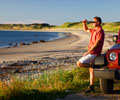The Vikings were fearsome warriors who conquered new lands. Their narrow, flat longships allowed them to cross the Atlantic. These boats were fast, capable of sailing both open sea and shallow water. They were made to be moored on a beach, yet light enough to be carried ashore. Viking boats combined wind propulsion with rowing power, which allowed them to sail down rivers. The Vikings in their boats could easily reverse on rivers or in ice floes without having to turn around, because the longships had bows at both ends.



At the northern tip of the island of Newfoundland In North America are the remains of the buildings that are thousand years old. L'Anse aux Meadows is officially recognized by archaeologists as the Viking settlement dating from AD 1021. The Canadian National Park built a replica of the Viking village nearby.



A quote from one of the information board in L'Anse aux Meadows that helps to understand the importance of this place, "One hundred thousand years ago some of our ancestors left the cradle of humanity in Africa and slowly migrated east and west. When the Norse met Aboriginal North Americans in Vinland one thousand years ago, it represented the completion of human migration on Earth. Humankind had encircled the globe."




